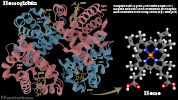II. Definitions
- Porphyrin
- Porphyrins are cyclic molecule composed of four pyrrole rings connected by methine bridges
- Porphyrins have a central mineral (e.g. iron in heme, cobalt in Vitamin B12, Magnesium in chlorophyll)
- Porphyrins vary by their side chains and central mineral
- Porphyrins are formed from the single pyrrol ringed molecule, Porphobilinogen
- Protoporphyrins
- Protoporphyrins are Porphyrins that have four methyl, two vinyl, and two propionic acid side chains attached to their pyrrole rings
- Protoporphyrin 9
- Protoporphyrin 9 occurs in heme, which is a the prosthetic group in Hemoglobin, myoglobin, and most cytochromes
- Protopoprphyrin 9 is activated when Protoporphyrinogen's methylene bridge is cleaved by the enzyme Protoporphyrinogen oxidase
- Heme

- Heme is a Protoporphyrin 9 based prosthetic group, with a central ferrous 2+ ion (iron)
- Heme in combination with globin Protein, forms Hemoglobin
- Heme is also the the prosthetic group for myoglobin and most cytochromes (combined with different globin Proteins)
- Unlike Hemoglobin which contains 4 polypeptide chains, myoglobin contains only 1 polypeptide chain
- While heme in Hemoglobin transports oxygen, the heme in cytochromes transport electrons (Electron Transport Chain)
III. Physiology: Heme Metabolism
- Hemoglobin breakdown occurs when Red Blood Cells are destroyed (e.g. in Spleen at the end of their roughly 120 day life cycle)
- Hemoglobin is converted into Biliverdin and ultimately into Bilirubin for excretion
- See Bilirubin
